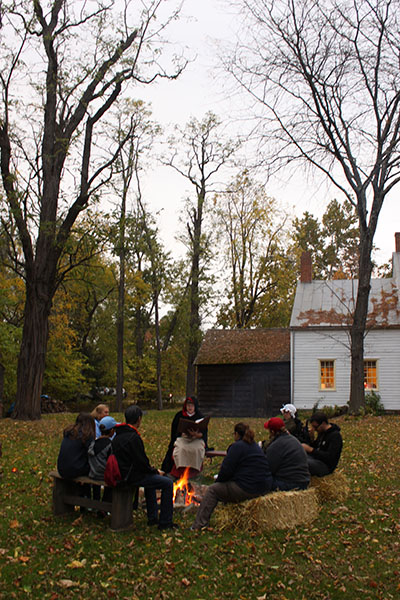

A Halloween-inspired walking tour of Huguenot Street highlighted the French Huguenot’s burial practices as they evolved through the colonial period.
Blending history and legend, Historic Huguenot Street’s Night Shift Tombstone Tour led more than 200 guests to 12 tombstones and the burial ground’s adjacent to the French Church after sunset on Oct. 19.
Dating back to 1677, Huguenot Street is one of the earliest colonial settlements in the country and its burial ground is one of the first in Ulster County.
“New Paltz started with 12 simple families trying to find their way in this wilderness,” said Manager of Visitation and Development, Thomas Weikel. “Early graves were simply a depository for the dead – there was very little mourning that went along with it.”
The earliest graves had little more than simple markers – but that changed as time went on, Weikel said. Elsie and Joseph Hasbrouck, whose pair of gravestones sit side by side, are the earliest examples of artwork in the Huguenot cemetery. Both feature carvings of wings – an angel, in the case of Elsie’s.
“The pair of stones are physically made of different material and very artistically created,” Weikel said.
Eight SUNY New Paltz students – including three interns – helped to organize the event, according to Susan Stessin-Cohn, Historic Huguenot Street’s Director of Education.
“We couldn’t do it without SUNY volunteers,” Stessin-Cohn said.
Third-year history major Zachary Rousseas and fourth-year education major Natasha Davidson both intern at Historic Huguenot Street and helped organize the tour.
Rousseas said much of his work consists of researching the lives of former Huguenot Street inhabitants including enslaved Africans and indigenous people. During the tour they reenacted a “ghost marriage” inside the French Huguenot Church – a ritual where Huguenot brides would follow through with a wedding ceremony after their groom had passed away.
At one point visitors gathered around a campfire set up on the Huguenot grounds to hear ghost stories. One legend, Weikel said, centers on a Hasbrouck who was dying of tuberculosis. In her final days she asked her son for a kiss. Her son, fearing taking ill, refused. The story goes that she haunts the grounds to this day longing to kiss her son goodbye.
“The history in this area is so rich and that’s something that I’m starting to see a lot more now that immersed in it and learning more about the history,” Davidson said.
